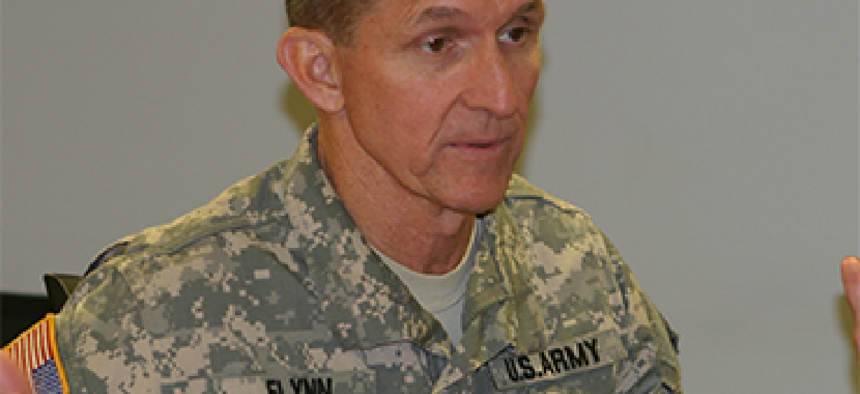Can DIA become the Defense Innovation Agency?

The Defense Intelligence Agency wants to be an innovation leader in the government, and it is overcoming old habits to do so.

DIA Director Lt. Gen. Michael Flynn, shown here speaking at a meeting in 2012, says DIA has to 'break down legacy walls' to emerge as an innovation leader. (Army photo)
"Innovation" is pretty big as far as government buzzwords go. Often found hand-in-hand with "doing more with less," the idea of innovation is one that seems to excite leaders and frequently surfaces in briefings and talking points.
But what is actually getting done? Who is really out there taking innovation for a spin?
The intelligence community might not immediately seem like the leader, but if the Defense Intelligence Agency has anything to say about it, it is in the driver's seat.
"The agency was established to understand the plans of the adversary. In the process of that, we became an organization that focuses on planning," said Dan Doney, DIA's chief innovation officer. "Planning and sticking to the plan are the opposite of innovation. Innovation is deviating from the plan, rapidly moving it and changing. When it comes to innovation, we haven't had a great reputation. Put that in the past."
Today, DIA is moving forward with what officials call an entirely new approach -- one that eradicates traditional silos, aggressively seeks outside input and quickly implements new ideas. The objective is to avoid strategic surprise and push forward with a new way of conducting the government's intelligence business after more than a decade of war.
"We have to break down legacy walls," DIA Director Lt. Gen. Michael Flynn said at the agency's June 27 Innovation Day at its Washington headquarters. "Innovation is not just about technology -- it's about a lot of things. Pay close attention to how this organization has adjusted and what we're working toward.
Training, education and professional development are a big deal. We can't lose the gains from the last decade."
The biggest area of focus in DIA's new approach is information sharing. The year-old Intelligence Community IT Enterprise (ICITE) is designed to link the 17 intelligence agencies and significantly reduce IT costs.
Among DIA's contributions to ICITE is the Innovation Gateway, an online information-sharing environment that forges easier connections between the intelligence community and industry. The goal is to help the agencies identify and adopt better solutions, particularly those that might not have surfaced without such a system. "No more middle man," Doney said. "No more cloudiness, no more special relationships where you need to know the right person to know what we're looking for."
Reaching out to industry
Users access the gateway via DIA-granted public-key infrastructure credentials. Much of the environment uses a wiki-style format, which is fitting for a system designed to free people from the constraints of standardization.
"There are some tricks associated [with] making a coherent environment that isn't coherently planned, but the first place you show up to...is a wiki, where you're made aware of the capabilities of the space," Doney said. "Underneath that is a description for how a technology provider participates in the space...and they're able to offer their technologies within the space, they're able to link to a set of core services" for others to access.
To protect against potential theft of intellectual property, the system has safeguards in place in the form of what Doney called stakeholder management authorization.
"One of the advantages is that providers host their own [areas], so they maintain complete control over their own capabilities, technologies and configurations," Doney said. "They're not constrained by other people's ways of doing things."
The gateway is still in its early stages, but officials expect initial operating capability in December. Reaching critical mass in terms of users will be the key to the project's success and progress, Doney said. He likened getting there to the early days of Wikipedia, when the popular online resource relied on passionate early adopters to generate content.
"The first phase is the hardest," he said. "It takes action and energy to get over the initial barriers."
Measuring results
Another tricky aspect of the Innovation Gateway is measuring success, particularly by traditional government models, officials said.
"There's not going to be one way to look at it and either you passed or failed. It's going to be all-encompassing," said Janice Glover Jones, DIA's deputy CIO. She added that productivity is one key marker, but success writ large will be a little tougher to define. "And even if you fail, you get lessons learned." Doney, too, indicated that the focus should be on the less tangible goals.
"Innovation is a means, not an end," he said. "We're driven by mission, so the bottom line is how much better are we able to execute on our mission, not whether or not we're the best innovators in the world. It's a mistake many folks make to measure the means instead of the ends."
Still, he pointed to his "stretch goals" as crucial milestones, such as the 30-day transition requirement that reforms discovery, evaluation, integration and acquisition. Other goals are characterized by the existence of cross-functional teams of analysts, collectors and technologists who work together seamlessly; rapid access to tools and capabilities; and the availability of mission-relevant data.
The goals illustrate the agency's wider drive to get back on track after the wars in Iraq and Afghanistan, which drastically changed the business of government.
"We've exercised the wrong muscles. We have to go back to a place where we exercise the right muscles and think about how we conduct business," Flynn said. "We have to allow for failure.... It's a risk, but that's OK. The return on investment on risk is so good."
Editors' note: This article was modified to correct Janice Glover Jones' title.





